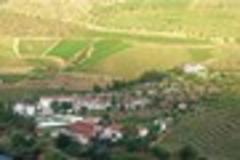 This is Devon --
This is Devon --Port vintages don't just happen. They are declared. There is, obviously enough, a harvest every year in the Douro Valley of northern Portugal where the grapes for port are grown. But the quality of the fruit varies according to the notoriously inconsistent weather of the region. Only every now and then will all the ideal conditions coalesce.
This is all in the context of true "vintage port" in its strictest meaning. That is, the wine of a single year made from the pick of the harvest. Like all port, it is fortified with spirit and run into casks to begin the ageing process, but proper vintage ports remain for a comparatively brief two years in their pipes (large casks) before bottling.
The bottles are now ready for a long slumber. For at least a decade, maybe several, the bottles must be "laid down" in a cool, dark, quiet place to allow the metamorphosis of the raw, ardent blend into the luscious, mellow ambrosia that is mature vintage port.
These are the flagship wines of the port shippers. So when a vintage is declared, they shout the news from the rooftops of Vila Nova de Gaia, the enclave of Oporto at the mouth of the Douro river where most of the shippers have their lodges, the stores where the wines are blended and sampled, bottled and stored.
And this week, the news is that the 2011 vintage has been declared. Several of the shippers are sufficiently pleased with the wines from that year, currently still snoozing in their pipes, that the very best of them are worthy of bottling under that auspicious date.
Adrian Bridge, managing director of the Fladgate Partnership, the company behind two of the very grandest port names, Fonseca and Taylor's, says: "2011 has produced textbook vintage ports, classics in every sense. The wines have a wonderful purity and elegance but also plenty of background and structure."
The declaration doesn't just come out of the blue. In the lodges, the teams of winemakers spend weeks sampling wines from their various vineyards (only wines from the shippers' own properties go into vintage bottlings), held in numerous different casks, building painstakingly towards the final blend. They're looking for quality, of course, but also for the more-elusive elements of potential longevity and consistency of house style.
It's a picturesque business, convincingly portrayed in the phrasing of an expert such as David Guimaraens, head winemaker at Fladgate. "The 2011s stand out for the purity of the fruit and the quality of the tannins, which are silky and well integrated but provide plenty of structure," he says. He is thankful for the conditions in the Douro in the run-up to the 2011 harvest. "Abundant spring rainfall created reserves to keep the vines well supplied with water throughout the hot, dry summer. This resulted in balanced ripening and wines that have elegance as well as depth and stamina."
Observations like this bring the delights of port very much to life. The blending of the young wines in search of the perfect finished product is a taxing business, because they are black-as-night, fiery and tannic, but the people who do it have an almost supernatural understanding of how the blend will evolve over many years to come.
Of course it's a long wait for the results. But port, happily, is a continuum. Vintages from long ago are among the great treasures of the wine world. They are correspondingly expensive. Expect to pay £50 upwards for a vintage approaching its maturity. At the Wine Society, both Fonseca and Taylor's from the 1985 vintage, now coming around nicely, are priced at £75 a bottle. Port devotees like to get in early. When a new vintage is declared, the shippers make a first offer of the wines to the trade, so later this year, the 2011s will be on the market through specialist wine merchants.
I will not try to guess how much will be asked for the top names, but whatever the price, there is every likelihood it will rise over time.
Demand for these wines, with or without continued economic gloom, is growing. Traditional markets in Europe and America must now compete for the limited supply available with keen new enthusiasts in the Far East, and in South America, where the former Portuguese colony of Brazil is prospering mightily and acquiring a taste for the wines of the old country.
Says Adrian Bridge: "Wine consumers all over the world are realising that vintage port continues to deliver astonishing value compared to many other classic wines."
He's right about value. Top red Bordeaux wines, which can in no way claim any higher intrinsic value, or rarity, than top vintage ports, are priced on a wholly different level. You can buy a six-bottle case of Taylor's 2009 (the previous declared vintage) for about £300. Six bottles of a Bordeaux counterpart such as Château Latour will set you back £6,000.
The worry is that demand for the great vintage ports will some day explode into the madness that has overtaken the claret market, and none of us will be able to afford to drink these fabled wines. An excellent reason to invest now. That's what I declare. Reported by This is 7 hours ago.